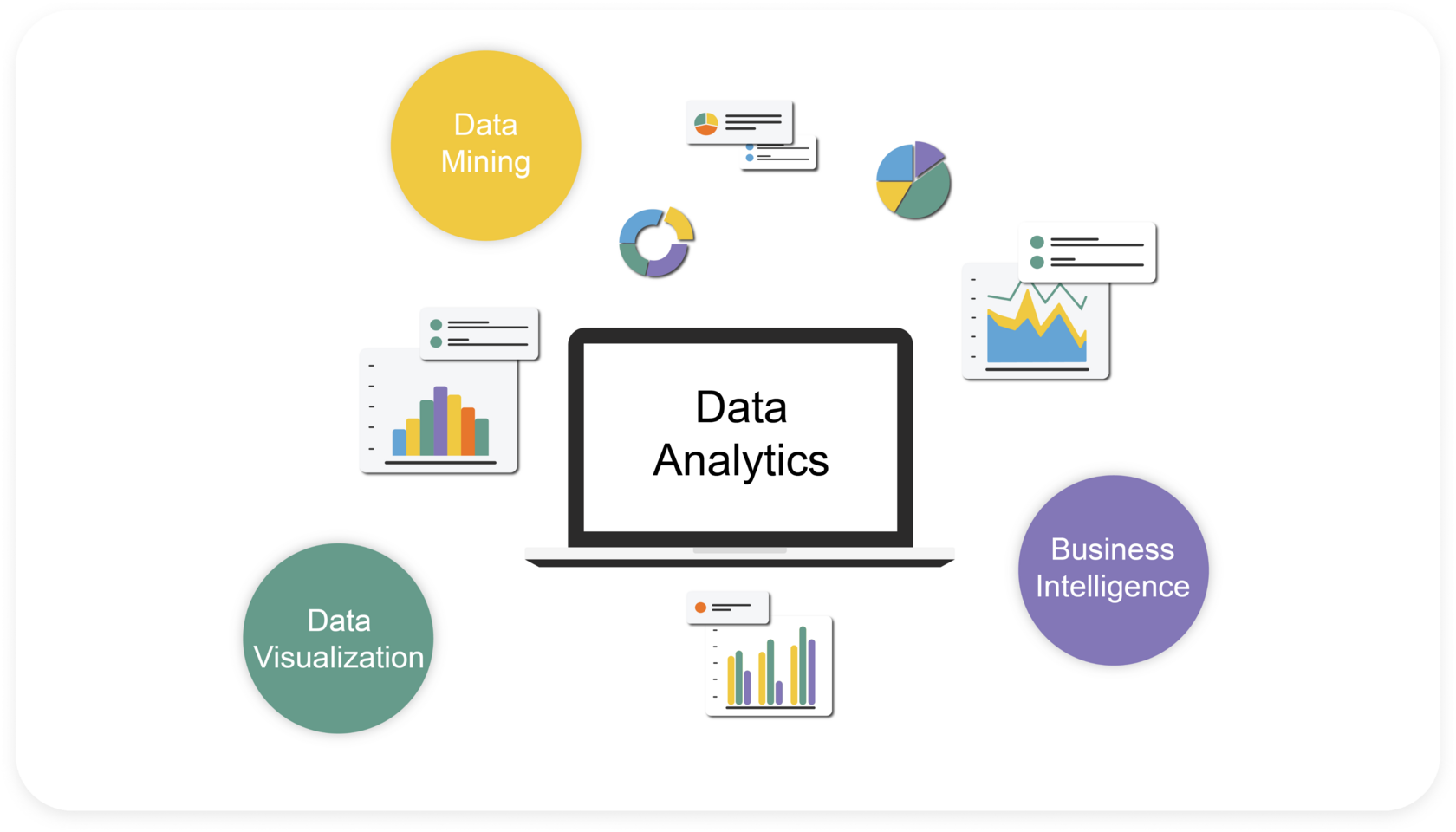Business
Best Data Analytics Tools for Businesses to Make Smarter Decisions

Introduction to Best Data Analytics Tools for Businesses
The required and needed the analytical data is essence of the necessity of businesses. Data is the primary means through which business make decisions in their organizations. Whenever one has necessary tools, one may be in a position to analyze trends in addition to improving on its operations as well as competitive advantage.
In selecting data analytics tools for business, decision makers ensure that they use instruments that provide actual values. This article aims to define the tools of analytics that can be effectively used to facilitate decision-making process that can lead to the growth of organizations.
What Are Data Analytics Tools?
Business intelligence tools assist in the collection and analysis of data with the help of database systems. These tools help in converting the crude data into useful information. Business organizations employ them in measuring their performances and that of their customers and competition.
There are basically three key functional aspects of data analyse in modern software, which include automation, technique to present data graphically, and the prediction feature. It also helps in enhancement of decision making and the best models for business solutions.
That is why when it comes to choosing tools that will be of importance to an organization, managers should ensure that they select those tools that will increase their productivity and thus the profits achieved in the business.
Benefits of Using Data Analytics Tools
Data Analysis Tools provides increase business productivity. They improve decision-making processes that integrate current data insights into the processes that are going on at the moment. The application of business is useful in every sphere in order to identify patterns and see trends and if there is any possibility to minimize risks.
Thereby they facilitate actions, cut expenses, and accomplish goals. The Analytical tools also benefit customers. They also make it easier in enhancing the marketing strategies and offering tailor-made advice.
To ensure one steps ahead of the other in the business, data is essential and is used by companies. Tools pertaining to the right field gave the much needed boost to innovation and revenue streams.
Most Effective Tools for Analyzing Data in Business
1. Google Analytics
Google Analytics is a feature of the Web that provides qualitative and quantitative measurement analysis of the website and its users. It measures Internet websites, visitor’s activities, and sales. Organizations apply it to track effectiveness of their online presence and subsequent marketing campaigns.
Google Analytics permits user to obtain extensive and real-time analysis reports. It assists business people to understand the audience base and their characteristics.
Self-service and automations allow companies to have powerful visualizations and use them to make decisions. It has become one of the essential tools for any business that is operating in the digital environment.
2. Tableau
Tableau is an excellent market-leading, business intelligence and analytics tool used mainly for data visualization. It is particularly used in producing effective interactive dashboards and reports that assist businesses. The development of draggable widgets enables users with no scripting capabilities to interact with data.
As highlighted by KTH, Tableau can connect to multiple data source so that there is an all-rounded analysis. It is helpful in real-time and has a forecasting functionality.
It is used in business for trend analysis and also for the analysis of performance. Tableau allows for shaping, preparing and analyzing data in a way that it can be received, understood and used.
3. Microsoft Power BI
Power BI is a business intelligence tool which forms part of the Microsoft set of products. There are features that include data visualization, reporting and analysis. Power BI is utilized in business organizations in order to analyze data from different sources.
It has artificial intelligence and base on cloud computing. It is used to create interactive visualizations in dashboard and automated reports.
Power BI is compatible with other Microsoft tools such as excel, and Microsoft azure. Another advantage that can be derived from the use of CBN is that it aids the organizations in decision-making activities based on data.
4. Apache Spark
Apache Spark is an open source cluster computing system mainly used for data processing. The following are some of the advantages that makes R feasible to handle large scale data analytics. There are two categories in which businesses employ Spark – the real-time processing and batch process.
It also has capabilities in machine learning as well as graph analysis. It is also efficient in processing big data than other tools for the following reasons.
Well it also works with Hadoop and cloud platforms. It is widely used by different companies to analyze large datasets. Spark enhances the quality of business and its intellectuality.
5. SAS Analytics
SAS Analytics is an analytics software with a highly elevated level of credibility. They offer state of the art, statistical analysis and prediction modeling. SAS is used in business for data mining, prediction and evaluation of risks. It is helpful in making better decisions in marketing, in the area of finance, and in operations.
SAS supports AI-driven decision-making and automation. First, it means that protection of data is enhanced and accord with the requirement is met. The obtained information is most suitable for deep analysis by companies and organizations.
6. Qlik Sense
As it pertains to data analysis, Qlik Sense is more of a business intelligence software to be used by users with or without the assistance of IT. It has graphs and AI assistances which makes it enhanced with a number of indicators. Qlik Sense is used for discovery and analysis of data by the businesses.
Indeed, it is the ability to collaborate on data in real-time and tell its story. As for the organizational aspect, the tool permits the connection with numerous sources of information.
Qlik Sense offers the feature of updated data processing and notification. They also help an organization to be proactive in matters that surround it enabling it to take anticipative action.
7. IBM Cognos Analytics
IBM Cognos Analytics is a business intelligence software that is an artificial intelligence based tool. It also offers automated process of data gathering, cleaning and exploring. Cognos is used by businesses for creating reports and managing the dashboards of an organization. It can be deployed on cloud and also on-premise.
With the help of artificial intelligence, Cognos is designed to provide companies with solutions for analysing large volumes of data.
Organization change enhances decision making and for that matter operation operationally. It ensures that procured data is accurate and has compliance with the standard norms and requirements.
8. Looker
Looker is an innovative data visualization tool that is owned by Google Cloud. It comes with real-time analysis and dynamic reporting in the form of interface and dashboards. Nowadays, Looker is an application for business intelligence and data analytics that can be embedded.
It can work with cloud databases in a very effective manner for connectivity. Dimensions are Looker’s tools for discovery, analysis and advertising, which include artificial intelligence options.
Those cosmetics assist in improving marketing and selling, as well as managing operations of different organizations. It fosters the data-oriented culture in the use of business processes.
9. Domo
Domo is an analytical tool that can be accessed through the internet or Web-based software solution. It gives the opportunity to evaluate results and outcomes in real-time manner and create reports based on received data. Some of the ways stakeholders can leverage the business intelligence tool are as follows.
It provides notifications and use of artificial intelligence in analysis feature. Domo has mobility and it is highly collaborative based on mobile accessibility.
It promotes a better assessment of various factors of performance and encourages business organizations to measure their KPIs. It has the effect of improving the business agility & competitiveness.
10. Zoho Analytics
Zoho Analytics describes itself as easy to use Business Intelligence tool. Information and data obtained from the company can be easily analyzed using self-service tools augmented with analytics and even custom dashboards. Zoho Analytics is used for numerous business measures and insights purposes.
The tool is interoperable with different source of data. It supports artificial intelligence and automation of some aspects of the game. Zoho Analytics supports businesses in improving their efficiency and effectiveness in performance and quantitative reasoning. It is mostly suitable for the small and the medium business ventures.
How to Choose the Best Data Analytics Tools for Your Business
The use of the right data analytics tool depends on the need of the business. Other factors such as data volume, integration, practical use and others can also be looked at. Search for the features such as automation, AI and visualization. Make sure that the tool will be easily scalable and secure.
With the help of the comparison matrix based on 3 aspects, namely, pricing, customer support, and reviews, the most suitable provider should be closely examined. It is thus essential to select the most appropriate automation tool that would fit the business objectives and goals of the undertaking.
It is important to identify the best social media analytics platform for an organization in order to improve operations and organizational decisions for the best yields possible.
Conclusion
Business analytics tools enable organizations to gain critical information that is useful in decision making. These tools of data analytics may well be defined as those tools that facilitate business decision-making while also enhancing business productivity.
Metrics such as Google Analytics, Tableau, power BI helps in effective presentation of data and tracking. Advanced platforms like Apache Spark and SAS Analytics support big data and AI-driven insights.
Selection of the proper tool helps in more growth and competitiveness. Such solutions include categorical standards for investment to achieve success in today’s world that is filled with lots of data.
Business
How to Start a Business Without Money: A Complete Guide

The dream of launching a business often feels tied to a hefty bank account. Many aspiring entrepreneurs believe significant startup capital is a non-negotiable prerequisite, putting their ambitions on hold indefinitely. But what if you could turn your vision into a reality without a financial safety net? It is entirely possible to learn how to start business without money by leveraging your skills, time, and strategic thinking. This guide will walk you through actionable steps and proven models to get your venture off the ground with zero investment.
This comprehensive guide will explore practical strategies for launching a successful enterprise. We will cover service-based models that turn your expertise into cash, explore online ventures like dropshipping, and provide a step-by-step plan to validate your idea, find your first customers, and build a sustainable brand from scratch.
Understanding the “No-Money” Business Model
Starting a business without money isn’t about magic; it’s about resourcefulness. The core principle is to trade your time and skills for revenue instead of investing cash. This approach, often called bootstrapping, forces you to be lean, creative, and focused on generating income from day one. The most successful zero-investment business ideas fall into a few key categories where you are the primary asset.
Service-Based Businesses
This is the fastest path to revenue when you want to start a business with no money. You are selling your expertise, a skill you already possess. This eliminates the need for product development, inventory, and manufacturing costs.
Examples include:
- Consulting: Offer your professional knowledge in areas like marketing, finance, or HR.
- Freelancing: Provide creative or technical services like writing, graphic design, web development, or video editing.
- Coaching: Help others achieve personal or professional goals in fitness, career development, or life skills.
- Local Services: Offer services like pet sitting, house cleaning, tutoring, or handyman repairs.
Digital Product Businesses
Digital products have a significant advantage: you create them once and can sell them infinitely without any recurring manufacturing or shipping costs. This model is highly scalable and perfect for a side hustle.
Examples include:
- E-books and Guides: Write about a topic you know well and sell it as a downloadable PDF.
- Online Courses: Create video or text-based courses on platforms like Teachable or Udemy.
- Templates and Tools: Design resume templates, social media graphics, or project management spreadsheets.
Reselling and Dropshipping
These models allow you to enter the e-commerce world without holding inventory. You act as the middleman between the customer and the supplier.
- Dropshipping Business Model: You create an online store and list products from a third-party supplier. When a customer makes a purchase, you forward the order to the supplier, who ships the product directly to the customer. You profit from the difference between your retail price and the supplier’s wholesale price.
- Print-on-Demand: You create designs for products like t-shirts, mugs, or posters. A print-on-demand company handles the printing and shipping only when an order is placed.
A Step-by-Step Plan to Launch Your Business
Knowing the models is one thing; executing the launch is another. Follow these steps to systematically build your business from the ground up.
Step 1: Identify and Validate Your Business Idea
Before you invest your time, validate that people will actually pay for your idea. Start by brainstorming skills you already have or problems you can solve. What do friends and family ask for your help with? What are your passions and areas of expertise?
Once you have an idea, perform simple market research:
- Talk to Potential Customers: Reach out to people in your target audience and ask if they would pay for your proposed solution.
- Analyze Competitors: Look at what similar businesses are doing. Identify their strengths, weaknesses, and pricing. This will help you find a gap in the market or a way to offer a superior service.
- Create a Minimum Viable Offer (MVO): This is the simplest version of your product or service you can offer. For a freelance writer, it could be a single blog post. For a consultant, a one-hour strategy session. The goal is to get your first paying customer quickly.
Step 2: Leverage Free Tools and Platforms
Your lack of funds is not a barrier to looking professional. Countless free tools can help you manage and market your new venture.
- Website & E-commerce: Use platforms like Fourthwall or a free trial on Shopify to create a professional-looking online store. For a simple portfolio, Carrd is an excellent option.
- Design: Canva provides free templates for logos, social media posts, and business proposals.
- Marketing: Establish a presence on the social media platforms where your audience spends their time. Create valuable content that showcases your expertise.
- Communication: Use a free Gmail account for professional email and Google Workspace for documents and spreadsheets.
- Scheduling: Tools like Calendly offer free plans to let clients book appointments without back-and-forth emails.
Step 3: Build Your Brand and Online Presence
Your brand is more than just a logo. It’s the story you tell and the feeling customers get when they interact with your business. Define your brand’s voice, values, and what makes you unique.
Use social media not just to sell, but to build a community. Share helpful tips, behind-the-scenes content, and client testimonials. Consistency is key. Post regularly to build trust and stay top-of-mind with your audience. Engaging with your followers by responding to comments and messages helps build a loyal customer base.
Step 4: Find Your First Customers
Getting your first few clients is crucial for momentum and social proof.
- Tap Your Network: Let your friends, family, and former colleagues know what you’re doing. A personal referral is one of the most powerful marketing tools.
- Offer an Introductory Rate: To secure your first few clients, consider offering a one-time discount in exchange for a testimonial. This feedback will be invaluable for marketing to future customers.
- Join Online Communities: Participate in Facebook groups, Reddit forums, or LinkedIn groups related to your industry. Offer valuable advice without being overly promotional. This establishes you as an expert and can lead to inbound inquiries.
Step 5: Reinvest Profits for Growth
Once you start generating revenue, resist the urge to spend it all. The smartest way to grow is by reinvesting a portion of your profits back into the business.
Your first investments should focus on areas that save you time or help you acquire more customers. This could mean upgrading to a paid software plan, purchasing a better piece of equipment, or experimenting with small-scale digital advertising. This disciplined approach is a cornerstone of learning how to start business without money and scaling it successfully.
Starting a business without a financial cushion requires creativity, hustle, and a strategic mindset. By focusing on service-based models, leveraging free tools, and prioritizing customer acquisition, you can build a profitable venture from scratch. Remember that your most valuable asset is your own skill and determination. The journey of understanding how to start business without money is challenging, but it builds a resilient foundation for long-term success.
Business
What is Cloud Kitchen Business? A Comprehensive Guide to Success

The restaurant industry has undergone a seismic shift in the last decade, moving away from high-rent dining rooms toward a model built entirely for speed and convenience. If you are an aspiring restaurateur or a seasoned chef looking to expand without the crushing overhead of a traditional venue, you have likely encountered the term. But what is cloud kitchen business exactly, and why is it disrupting the trillion-dollar food service industry?
Simply put, a cloud kitchen—also known as a ghost kitchen, dark kitchen, or virtual restaurant—is a commercial cooking facility that has no physical dining area for customers. It exists solely to produce food for delivery. Orders come in through third-party apps like UberEats and DoorDash or an internal ordering system, and food goes out the back door directly to the customer’s doorstep. This model strips away the front-of-house complexities, allowing operators to focus purely on the food and the logistics of getting it to the customer hot and fresh.
The Evolution of Dining: Understanding the Concept
To truly grasp what is cloud kitchen business models offer, we must look at the inefficiencies of traditional hospitality. A standard brick-and-mortar restaurant spends a massive portion of its revenue on prime real estate, interior design, furniture, and front-of-house staff (servers, hosts, bartenders).
In a cloud kitchen, those costs vanish.
How It Works
The operational flow is streamlined for efficiency:
- Order Receipt: The customer places an order via a delivery app or website.
- Preparation: The kitchen staff receives the ticket instantly on a Kitchen Display System (KDS).
- Handoff: The meal is packaged in tamper-proof containers and handed to a delivery driver.
- Delivery: The food arrives at the customer’s location.
Different Names, Same Game
You might hear various terms thrown around, but they generally refer to the same concept:
- Ghost Kitchens: Usually implies a facility housing multiple brands.
- Virtual Brands: A restaurant that exists only online, potentially operating out of an existing restaurant’s kitchen.
- Dark Kitchens: A term often used in Europe to describe these delivery-only fulfillment centers.
Why Entrepreneurs Are Flocking to This Model
The explosion of the delivery-only model isn’t just a trend; it’s a financial strategy. When you analyze what is cloud kitchen business efficiency compared to traditional dining, the advantages become clear.
Slash Your Overheads
This is the biggest draw. You don’t need a location on Main Street with heavy foot traffic. You can rent a space in an industrial park or a basement in a densely populated area for a fraction of the cost. Furthermore, you eliminate the need for servers, busboys, and hosts, significantly reducing your labor costs.
Scale at Speed
Expanding a traditional restaurant chain takes years and millions of dollars. With a cloud kitchen, if you have a successful burger concept in one city, you can launch that same brand in a new city in a matter of weeks by renting space in an existing ghost kitchen facility.
Data-Driven Decisions
Because these businesses are digital-native, you have access to incredible data. You can track exactly which items sell best at what times, customer demographics, and delivery radiuses. This allows you to optimize your menu in real-time, removing low-margin items and doubling down on best-sellers.
Experimentation Friendly
Want to try a new vegan taco concept? In a traditional setup, you’d need new signage, printed menus, and a marketing overhaul. In a cloud kitchen, you simply launch a new brand on the delivery apps. If it fails, you turn it off with no sunk costs in physical infrastructure.
Navigating the Hurdles
While the model is attractive, it is not without risks. Understanding what is cloud kitchen business failure points is just as important as knowing the benefits.
The Visibility Problem
Without a storefront, you have no walk-in traffic. You are invisible to anyone not scrolling through a delivery app. This makes digital marketing your lifeline. You must be aggressive with social media ads, SEO, and optimizing your listings on delivery platforms to be seen.
High Commission Fees
Reliance on third-party aggregators (like Grubhub or UberEats) comes at a price. These platforms typically charge commissions ranging from 15% to 30% per order. While you save on rent, you pay in commissions. Successful operators often build their own direct ordering channels to bypass these fees.
Quality Control in Transit
Once the food leaves your kitchen, it is out of your hands. Traffic, weather, and driver behavior can all impact the food quality. Fries get soggy; soups get cold. Your packaging game must be impeccable to ensure the customer experience remains high.
Step-by-Step Guide to Launching Your Cloud Kitchen
If you are ready to dive in, here is a roadmap to getting started.
1. Market Research & Concept Development
Don’t just cook what you love; cook what the data says is missing. Look at delivery apps in your target area. Is there a surplus of pizza but a lack of healthy poke bowls? Find the gap in the market.
2. Finding the Right Location
You need a “Goldilocks” location. It doesn’t need to be pretty, but it needs to be functional.
- Accessibility: Can delivery drivers park and enter easily?
- Demographics: Are you within a 3-5 mile radius of your target customers?
- Infrastructure: Does the space have adequate ventilation, gas lines, and electricity?
3. Licensing & Paperwork
Even though you don’t have a dining room, you are still a commercial food facility. You will need:
- Business license
- Food service license
- Health department inspection and approval
- Liability insurance
4. Tech Stack & Equipment
Technology is the backbone of what is cloud kitchen business operations. You need a centralized system that aggregates orders from all different delivery platforms into one screen. Managing five different tablets during a dinner rush is a recipe for disaster. Invest in integrated software like Otter or Deliverect.
Financials Deconstructed: Setup Cost Breakdown
One of the most common questions is about the cost of entry. While cheaper than a restaurant, it is not free.
- Kitchen Equipment ($15,000 – $40,000): Ovens, fryers, prep tables, and refrigeration. This can be lower if renting a fully equipped “shell” kitchen.
- Technology ($1,000 – $3,000 upfront): POS systems, KDS screens, and tablet hardware.
- Licenses & Permits ($500 – $2,000): Varies heavily by city and state.
- Initial Marketing ($2,000 – $5,000): Photography, social media ads, and influencer outreach to launch your brand.
- Inventory ($2,000 – $5,000): Initial food stock and packaging materials.
Total Estimated Launch Cost: $20,000 to $80,000 depending on the model (renting a shared space vs. building your own). Compare this to the $250,000+ required for a traditional brick-and-mortar restaurant.
Future Trends: Where is the Industry Heading?
The sector is maturing rapidly. We are moving past the “wild west” phase into a more sophisticated era.
Automation and Robotics
To further reduce margins, major players are experimenting with automated cooking robots for repetitive tasks like frying chips or flipping burgers. This ensures consistency and lowers labor costs.
The Hybrid Model
Some operators are realizing that a little visibility helps. We are seeing “cloud kitchens with a window”—essentially a takeout kiosk that allows for customer pickup, cutting out the delivery middleman fees.
Direct-to-Consumer (D2C)
Brands are fighting back against aggregator commissions by incentivizing customers to order directly through their own apps. Offering loyalty points or lower menu prices for direct orders is becoming a standard strategy.
Conclusion
The food delivery landscape is here to stay, and virtual restaurants are the engine driving it forward. By stripping away the high costs of real estate and service staff, this model democratizes access to the food industry, allowing chefs to launch concepts faster and cheaper than ever before.
However, success requires more than just great recipes. It demands a mastery of logistics, a sharp digital marketing strategy, and a relentless focus on efficiency. Now that you understand what is cloud kitchen business models entail, you can decide if this high-tech, low-overhead approach is the right vehicle for your culinary ambitions.
Business
How to Start Import Export Business in India: A Comprehensive Guide

The global marketplace is more accessible than ever before, and India is currently positioned as a powerhouse in international trade. With government initiatives like “Make in India” and a target of reaching $2 trillion in exports by 2030, the timing has never been better for aspiring entrepreneurs. If you have ever wondered how to start import export business in India, you are standing at the threshold of a lucrative, albeit challenging, opportunity that connects local craftsmanship and manufacturing with global demand.
This guide moves beyond generic advice to provide you with a structured, step-by-step roadmap. Whether you are a manufacturer looking to expand globally or a merchant trader seeking new horizons, we will cover the regulatory frameworks, strategic planning, and operational execution required to succeed.
The Global Opportunity: Why Start Now?
Before diving into the paperwork, it is vital to understand the landscape. Import export business opportunities in India are surging across diverse sectors—from traditional textiles and spices to high-tech engineering goods and pharmaceuticals.
India’s diverse geography and skilled workforce offer a competitive edge. Understanding how to start import export business in India begins with recognizing the massive potential in these emerging markets. You aren’t just selling a product; you are selling India’s capabilities to the world.
Key Drivers of Growth:
- Government Support: Schemes like PLI (Production Linked Incentive) and RoDTEP (Remission of Duties and Taxes on Exported Products).
- Digital Infrastructure: Improved digital payments and simplified online customs processes.
- Global Diversification: International buyers are actively looking for “China Plus One” strategies, favoring Indian suppliers.
Step 1: Legal Framework and Business Setup
The legal formalities are often the most intimidating part of learning how to start import export business in India, but they are actually quite straightforward if you follow the correct sequence. You cannot trade internationally as an individual without a proper business structure.
1. Register Your Business Entity
You must first give your business a legal identity. You can choose a Sole Proprietorship for ease of setup, a Partnership Firm, or a Private Limited Company if you plan to raise funds later.
- Pro Tip: Choose a company name that is easy to spell and pronounce internationally.
2. Obtain a PAN Card and Open a Bank Account
Your business needs its own Permanent Account Number (PAN). Once you have this, open a Current Account with a bank that deals in foreign exchange. This is critical because you will be dealing with multiple currencies.
3. Get Your Import Export Code (IEC)
This is the most critical license you will need. The Import Export Code (IEC) is a 10-digit code issued by the Directorate General of Foreign Trade (DGFT).
- How to apply: It is a lifetime registration with no renewal fees. You can apply online through the DGFT portal using your PAN and bank details.
- Note: Without an IEC, goods cannot enter or leave the country legally.
4. Registration Cum Membership Certificate (RCMC)
To avail of benefits under India’s Foreign Trade Policy, you must register with the relevant Export Promotion Councils (EPC). For example, if you export tea, you register with the Tea Board; for engineering goods, it is the EEPC. This certificate is mandatory for claiming export incentives.
Step 2: Strategic Product and Market Selection
Many entrepreneurs ask how to start import export business in India successfully, and the answer often lies in meticulous product selection rather than complex logistics. You cannot sell everything to everyone.
Identifying Profitable Products
Conduct thorough market research for export business success. Look for products where India has a manufacturing advantage but international availability is low.
- Trending Sectors: Organic foods, ceramic tiles, leather goods, and handicrafts.
- LSI Keyword Tip: Use tools like the Indian Trade Portal to analyze trade statistics and demand.
Selecting the Right Market
Don’t just pick a country because you have a friend there. Analyze markets based on:
- Demand: Does the country import what you sell?
- Trade Barriers: Are there high tariffs or strict international trade regulations?
- Stability: Is the political and economic climate stable?
Step 3: Finding Buyers and Suppliers
Once you have your product, you need a counterparty. This is often the biggest hurdle for new exporters.
Digital Presence
In the digital age, a professional website is your showroom. Ensure it is SEO-optimized so international buyers can find you.
B2B Platforms and Trade Fairs
Register on portals like Alibaba, Indiamart, or Global Sources. However, physical connections still matter. Participating in international trade fairs helps build trust, which is the currency of global trade opportunities.
Leveraging Embassies
Indian missions abroad often have commercial wings dedicated to promoting trade. They can provide lists of potential importers in their respective countries.
Step 4: Pricing, Finance, and Risk Management
Another critical aspect of how to start import export business in India involves mastering the flow of goods and money. If you miscalculate your pricing, your export-import profitability will vanish.
Pricing Strategies (Incoterms)
You must understand pricing terms like FOB (Free on Board) and CIF (Cost, Insurance, and Freight).
- FOB: You cover costs until the goods are on the ship.
- CIF: You pay for shipping and insurance to the destination port.
Export Financing Options
Cash flow is king. You may need funds to manufacture goods before you get paid. Banks offer export financing options like:
- Pre-shipment Credit: Packing credit to buy raw materials.
- Post-shipment Credit: Finance against the invoice after shipping while waiting for payment.
Risk Management (ECGC)
International trade carries risks like buyer insolvency. The Export Credit Guarantee Corporation (ECGC) provides insurance policies that cover the risk of non-payment by foreign buyers. Never skip this step.
Step 5: Documentation and Logistics
Execution is where the game is won or lost. Errors in documentation can lead to shipments being stuck at ports, incurring huge demurrage charges.
Essential Export Documentation Requirements
You must prepare a precise set of documents for the customs clearance process:
- Commercial Invoice: The bill for the goods.
- Packing List: Detailed description of package contents.
- Bill of Lading / Airway Bill: Proof of shipment provided by the carrier.
- Certificate of Origin: Proves where the goods were made (crucial for claiming duty benefits in the buyer’s country).
- Shipping Bill: Filed electronically for customs clearance.
Partnering with Logistics Experts
Export-import logistics is complex. Hiring a competent Freight Forwarder or Customs House Agent (CHA) is highly recommended. They handle the heavy lifting regarding international trade regulations and transport, ensuring your goods move smoothly from factory to port.
3 Pro Tips for Sustainable Success
- Start Small: Do not try to execute a massive order as your first deal. Learn the cycle with smaller shipments to minimize risk.
- Verify Your Buyer: Always do a credit check on your buyer. Use the services of the ECGC or credit rating agencies.
- Communication: Time zones differ. Be ready to communicate late at night or early in the morning to close deals.
Conclusion
Entering the international trade arena is a bold move that requires patience, resilience, and a willingness to navigate complex systems. By following these steps to start import export business, securing the right licenses like the IEC, and understanding the nuances of logistics and finance, you position yourself for long-term growth.
The world is waiting for what you have to offer. Mastering how to start import export business in India is a journey of continuous learning, but with this comprehensive guide, you have the foundation to build a global enterprise that contributes to India’s economic story.
-

 BLOG1 year ago
BLOG1 year agoUnlocking Opportunities: Top Small Business Ideas in Hyderabad
-

 BLOG1 year ago
BLOG1 year agoTop Automotivе Businеss Idеas: Explorin’ Profitablе Vеnturеs in thе Auto Industry
-

 Business1 year ago
Business1 year agoHеartfеlt Bеst Wishеs for Nеw Businеssеs: Encouragеmеnt & Succеss Tips
-

 BLOG1 year ago
BLOG1 year agoMedicine Wholesale Business: An In-Depth Overview
-
BLOG12 months ago
Business Ideas in Tamilnadu: Profitable Options for Entrepreneurs
-

 BLOG12 months ago
BLOG12 months agoPart Time Business Ideas in Tamil You Can Start from Home
-

 BLOG1 year ago
BLOG1 year agoSmall Business Ideas from Home for Ladies: Empower Your Entrepreneurial Spirit
-

 BLOG1 year ago
BLOG1 year agoHilite Business Park Companies: Driving Economic Growth in the Region
